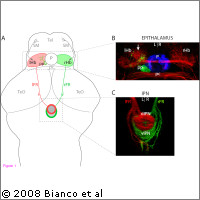Scientists observe differences in neuron wiring
For the first time, a team of UK scientists have observed how the left and right-sided nerve cells in a part of the brain called the habenula are wired. The study, which is partly EU-funded, is expected to shed further light on how brain asymmetries affect our cognitive, emotional and social behaviour. Our brain is made up of two halves - left and right - which are connected by masses of nerve fibres that allow 'messages' to pass between them. For instance, the right-side of the brain usually deals with emotions, while the left-side controls more analytical tasks such as language processing. However, until now, very little was known about the wiring of individual nerve cells and its effect on these processes. 'It's clear that the left and right halves of the brain process different types of information but almost nothing is known about the differences in the brain's circuitry which achieve this,' says Professor Stephen Wilson of University College London. 'One possibility is that totally different types of neuron might be found on the left and right. Alternatively, both sides could contain the same building blocks but put them together in different ways.' To investigate this, Professor Wilson and a team of researchers looked at the left and right-sided nerve cells in a part of the brain called the habenula. Using a focal electroporation to express a membrane-tethered green fluorescent protein (GFP) in individual neurons or small groups of habenular neurons, the researchers were able to visualise the entire morphology of these cells in the intact brain. They saw that there are two types of habenular neuron and both types can be found on both left and right sides. However, while most left-sided cells have spiral axons or nerve fibres shaped into a domed crown, these neurons are not very common on the right. Instead, most right-sided cells form flat, shallow spirals, and these are formed only occasionally on the left. 'In the same way that an engineer can make different electronic circuits from the same set of electronic components, so the left and right halves of the brain use the same types of neuron but in different combinations,' explains Isaac Bianco, one of the researchers involved in the study. The left and right habenular circuits both connect to the same part of the brain, and the researchers found that this target can either combine signals from the left and right or handle them independently. 'Even though language is processed largely on the left side of the human brain, people don't speak with only one half of their mouth. The brain must contain circuits which take information from the left or right and then send it on to targets on both sides of the body,' says Professor Wilson. The study, which is published in the open access journal Neural Development, is part of a larger EU-funded project entitled 'Evolution and development of cognitive, behavioural and neural lateralisation' (EDCBNL). The aim of the project is to provide a better understanding of the impact of brain asymmetries on cognitive and social behaviour.
Countries
United Kingdom



